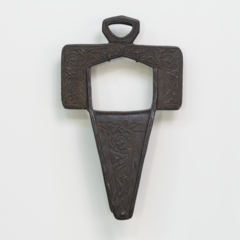"Los Estribos de Cruz" or cruciform stirrups, display the remarkable craftsmanship of Spanish Colonial blacksmiths working with wrought iron. It is believed that this style of stirrup was introduced to Spain by the Moors and after being out of use for some time, regained popularity throughout New Spain.
In the mid 1770's, Bishops of the Catholic Church called upon these stirrups to be restricted and if found destroyed due to their resemblance to a Bishops miter. The government also deemed these items as dangerous and excessive, due to their shape and weight (11 to 15 pounds) and began to restrict their use in Presidial Cavalry outfits.
Enforcing these restrictions on the frontier of New Spain would be difficult, many disregarded these edicts, while some riders would cut down the stirrups, therefore altering the design and lessening the weight in hopes of falling within the new guidelines. As style preference began to change along with new saddle and tack technology, these stirrups once again fell out of popularity.
This fine example of a cruciform stirrup is a piece from the Don and Louise Yena Spanish Colonial Collection, now on display in the Ralston Family Collection Center.



